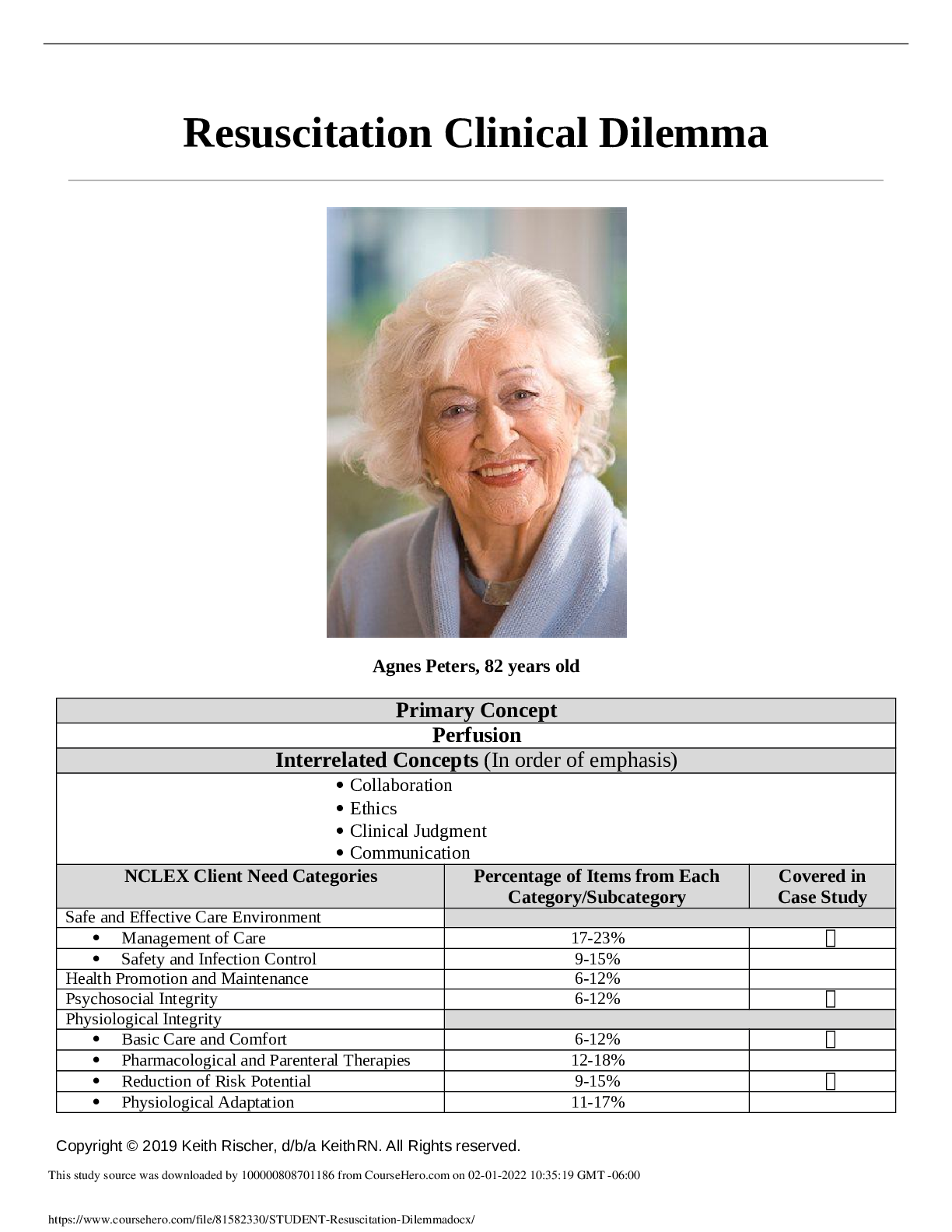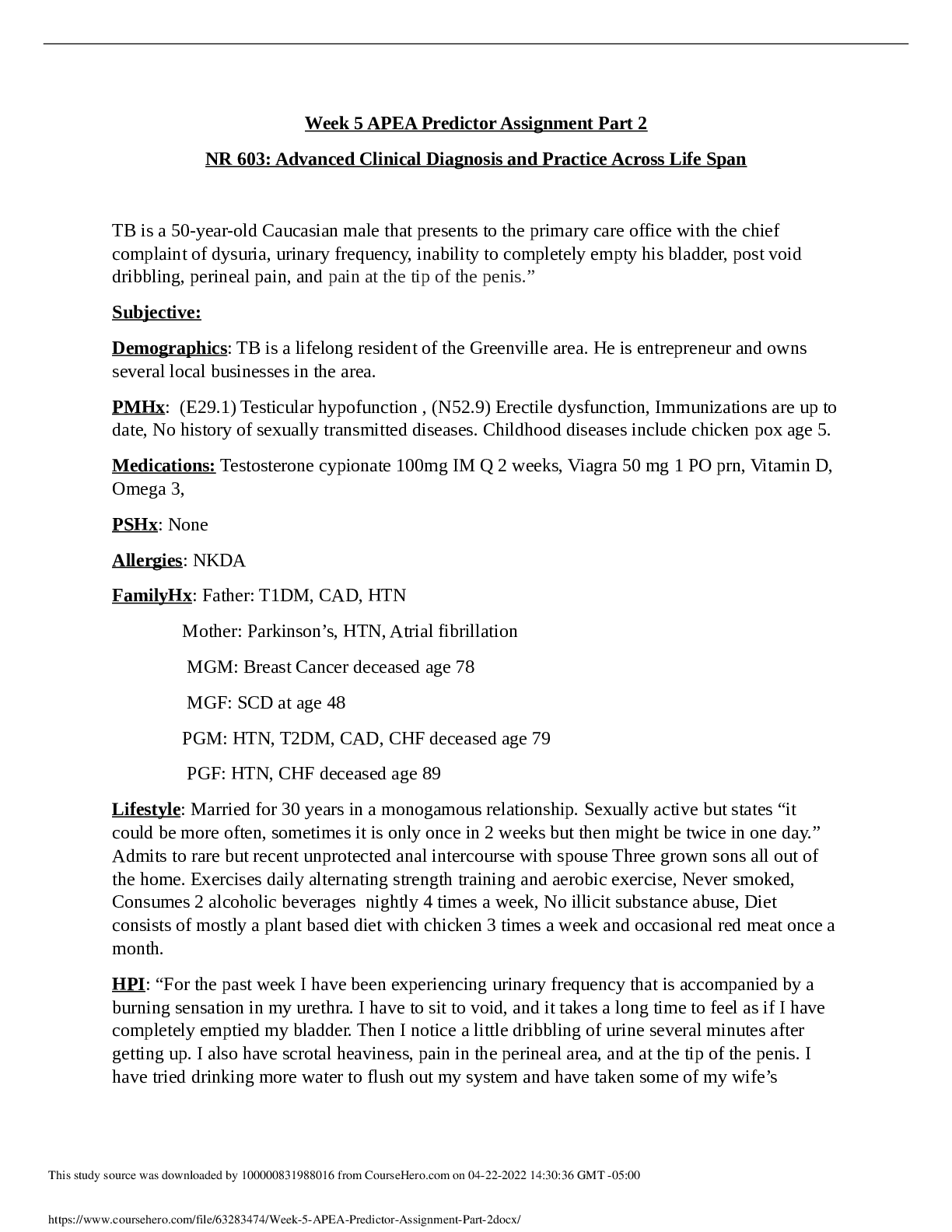*NURSING > CASE STUDY > NURSING 101 Sleep Apnea Case Study #2 (All)
NURSING 101 Sleep Apnea Case Study #2
Document Content and Description Below
Case Study #2 Sleep Apnea SR is a 59-year-old man who comes to the clinic because his wife complains “my snoring is difficult to live with.” 1. As the clinic nurse, what routine information wo... uld you want to obtain from the patient? • Routine information that would need to be obtained is as follows: o How long the snoring has been an issue o If SR takes any medications o What position does he normally sleep at night? o His normal daily routine and sleeping routine (this includes the time he goes to sleep as well as well as how long he sleeps every night) o His diet during the week o Any breathing difficulty during the daytime After interviewing SR you note the following: SR is under considerable amount of stress. He owns his own business. The stress of overseeing his employees, meeting deadlines, and carrying out negotiations as led to poor sleep habits. He sleeps 3 to 4 hours per night. He keeps himself going by drinking2 quarts of coffee and smoking 3 to 4 packs of cigarettes per day. He has gained 50 pounds over the 2 years, leading to a current weight of 250 pounds. He complains of difficulty staying awake, wakes up with headaches on most mornings, and has mid-morning somnolence. He states that he is depressed and irritable most of the time and reports difficulty concentrating and learning new things. He has been involved in three auto accidents in the past year. SR vitals signs are 164/90, 92,18, and SPo2 90% on room air. His examination findings are normal except for a few bruises over the right side of the rib cage. You inquire about the bruises and SR reports that his jabs him with her elbow several times every night. In her own defense the wife states “well he stops breathing and I get worried, so I jab him to make him start breathing again. If I don’t jab him, I find myself listening for his next breath and I can’t go to sleep.” You suspect sleep apnea 2. Identify two main types of apnea and explain the pathology of each. • The two main types of apnea is obstructive and central. “Obstructive sleep apnea (OSA) is a breathing disruption during sleep that last at least 10 seconds and occurs a minimum of five times in an hour.” (Ignatavicius 2018, pg. 559). With this type of apnea the airway is blocked either by the tongue and soft palate or air passages narrowing when the muscles relax during sleep. As a result, the air becomes physically blocked from entering the lungs and causes distress similar to being choked. This in turn awakens the brain, and to essentially awaken the airway muscles so normal airflow can occur. This continues patterned of disrupted sleep prevents deep sleep which is needed for best rest. This study source was downloaded by 100000808701364 from CourseHero.com on 03-29-2021 16:46:19 GMT -05:00 https://www.coursehero.com/file/69811682/Case-Study-2docx/ • Central sleep apnea occurs when the brain sometimes fails to awake the breathing muscles in the chest. Breathing muscles will work only when the brain gives them the signal to breathe therefore in this type the muscles of the chest and diaphragm fail temporarily. [Show More]
Last updated: 1 year ago
Preview 1 out of 5 pages

Buy this document to get the full access instantly
Instant Download Access after purchase
Buy NowInstant download
We Accept:

Reviews( 0 )
$7.00
Can't find what you want? Try our AI powered Search
Document information
Connected school, study & course
About the document
Uploaded On
Mar 30, 2021
Number of pages
5
Written in
Additional information
This document has been written for:
Uploaded
Mar 30, 2021
Downloads
0
Views
128













